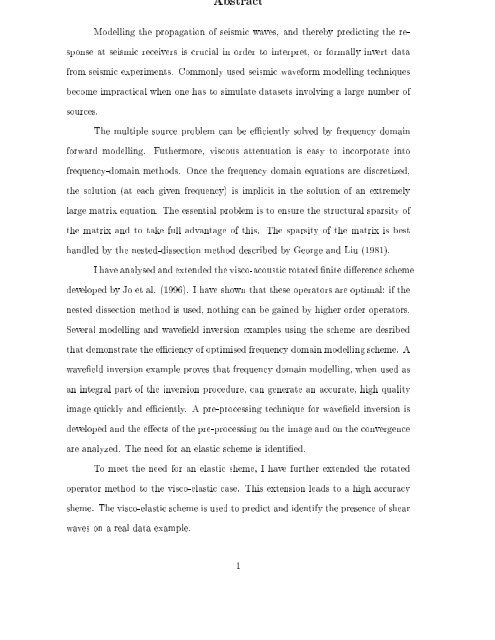Frequency domain seismic forward modelling: A tool for waveform ...
Frequency domain seismic forward modelling: A tool for waveform ...
Frequency domain seismic forward modelling: A tool for waveform ...
Create successful ePaper yourself
Turn your PDF publications into a flip-book with our unique Google optimized e-Paper software.
Abstract<br />
Modelling the propagation of <strong>seismic</strong> waves, and thereby predicting the response<br />
at <strong>seismic</strong> receivers is crucial in order to interpret, or <strong>for</strong>mally invert data<br />
from <strong>seismic</strong> experiments. Commonly used <strong>seismic</strong> wave<strong>for</strong>m <strong>modelling</strong> techniques<br />
become impractical when one has to simulate datasets involving a large number of<br />
sources.<br />
The multiple source problem can be eciently solved by frequency <strong>domain</strong><br />
<strong><strong>for</strong>ward</strong> <strong>modelling</strong>.<br />
Futhermore, viscous attenuation is easy to incorporate into<br />
frequency-<strong>domain</strong> methods. Once the frequency <strong>domain</strong> equations are discretized,<br />
the solution (at each given frequency) is implicit in the solution of an extremely<br />
large matrix equation. The essential problem is to ensure the structural sparsity of<br />
the matrix and to take full advantage of this. The sparsity of the matrix is best<br />
handled by the nested-dissection method described by George and Liu (1981).<br />
Ihave analysed and extended the visco-acoustic rotated nite dierence scheme<br />
developed by Joetal.(1996). Ihave shown that these operators are optimal: if the<br />
nested dissection method is used, nothing can be gained by higher order operators.<br />
Several <strong>modelling</strong> and waveeld inversion examples using the scheme are desribed<br />
that demonstrate the eciency of optimised frequency <strong>domain</strong> <strong>modelling</strong> scheme. A<br />
waveeld inversion example proves that frequency <strong>domain</strong> <strong>modelling</strong>, when used as<br />
an integral part of the inversion procedure, can generate an accurate, high quality<br />
image quickly and eciently. A pre-processing technique <strong>for</strong> waveeld inversion is<br />
developed and the eects of the pre-processing on the image and on the convergence<br />
are analyzed. The need <strong>for</strong> an elastic scheme is identied.<br />
To meet the need <strong>for</strong> an elastic sheme, I have further extended the rotated<br />
operator method to the visco-elastic case. This extension leads to a high accuracy<br />
sheme. The visco-elastic scheme is used to predict and identify the presence of shear<br />
waves on a real data example.<br />
1

















